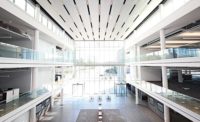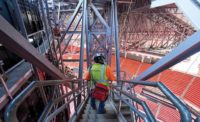Other green components include a north-facing building to maximize energy, light and shade, with minimal direct western exposure, clerestory windows on the south and EIFS wrapped around the structure to maximize energy efficiency. An 8-ft-high green screen on the north side and a projected trellis on the eastside parking center transition to the neighboring residential areas.
Recycled content is incorporated in the carpets, floors and ceiling tiles, and no- and low-VOC interior finish products were used. Locally or regionally manufactured materials were also chosen to minimize fuel consumption to the site, and recycled or local materials were maximized in construction.
A highly energy-efficient zoned HVAC system replaced the outdated original. A state-of-the-art fresh-air induction system has been installed in the Technical Service Center, coupled with an emissions vacuum system at each work station to reduce the facility HVAC capacity by 50 tons and cut energy consumption by 25 percent. Exhaust from the service bays is piped out, flowing through a chamber that slows down the air, decreasing noise levels to the community, Cartell explains.
In addition, 100-percent LED lighting and low-energy motion sensors reduce heat transmission and light pollution, using one-sixth of the energy for fixtures than traditional bulbs. Low-water-use plumbing fixtures and waterless urinals are installed in the restrooms.
Theisen, who grew up in Arizona, is proud of the company’s continuing environmental commitment.
“I am passionate about doing our part in the fight against global warming and pollution, as well as in serving as a steward for the environment,” he says.
The Community Joins the Ride
Mercedes-Benz of Scottsdale was also challenged to keep noise levels as low as possible for the existing and planned residential communities on both the north and south sides. The company met with neighborhood associations for input before construction and invited representatives for walkthroughs as it was opening to demonstrate the level of noise abatement.
Also challenging to the construction team was a dialysis center in a corner of the original building. This was kept operational through October 2013 to allow the company to build out its new space elsewhere.
“Everything ran smoothly, as planned,” he says.
Context and broader community issues also directed the design. A turntable on the Scottsdale Road façade is part of a museum/art component, Cartell says. On this showcase carousel, Scottsdale Mercedes-Benz will alternate signature contemporary or classic cars or those on loan from visiting auto auctions.
A pedestrian walkway adjacent to the carousel invites the community to walk “through” the new dealership from the Highland Avenue corner to the Blue Sky development planned just south of Scottsdale Mercedes-Benz without entering the new building.
“This is part of our desire to draw the community into the building,” Theisen says. Inside, a gallery wall will display automotive and other artworks, perhaps as a component of the city’s popular Art Walk series and other events.
Similarly, to encourage car customers inside through the challenging summer months, the project features more than 1.5 acres of conditioned vehicle showroom display and inventory area.
“We’ve taken the traditional car dealership and turned it around, placing a large inventory inside the building,” Cartell says. “Think about the benefit that comes from not having to shop for a new vehicle in the blazing Arizona sun and evening heat.”
He adds that because of contemporary demands, people want their new cars immediately, so inventory must be in place for this –– but not on scorching parking lots. “We have taken the six weeks my father expected for a new-car delivery and reduced it to two hours. And, we’ve brought everything indoors."








Post a comment to this article
Report Abusive Comment